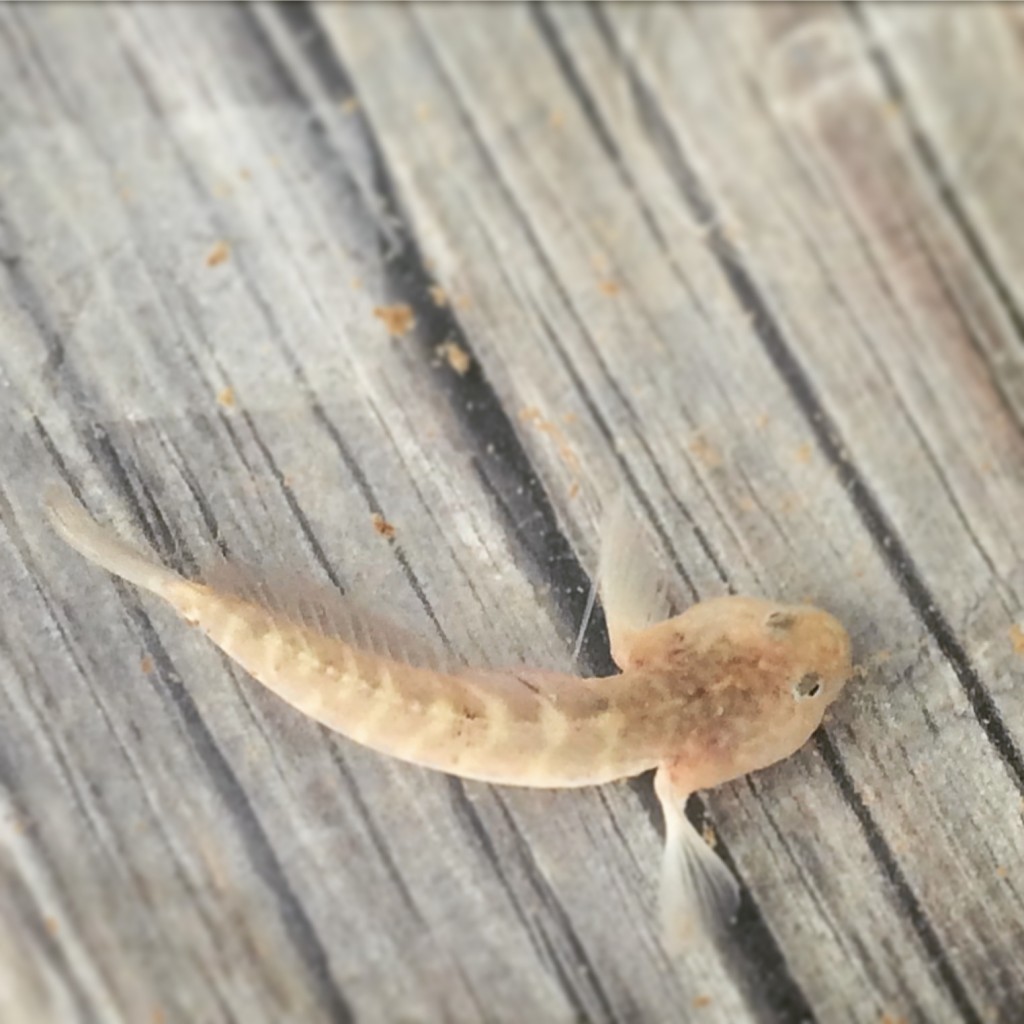by Chris Patrick
Plastic bread crates rest on the floor of the Rhode River, suspended by ropes from the Smithsonian Environmental Research Center’s dock. Eight PVC pipes arranged in a starburst sit horizontally on the bottom of the bread crates. In each tube there is a rolled sheet of thin, clear plastic. These rolled sheets are goby egg nests.
Or they’re supposed to be. Laurel Martinez, intern in the marine ecology lab this summer, slides out a plastic sheet and exclaims, “The mud crabs took over!”
This isn’t the plan. She wants the sheets to house naked gobies, bottom-dwelling fish. Martinez needs naked goby eggs for her summer project. Female gobies, who usually lay their eggs inside dead oyster shells, are supposed to go into the tubes, lay eggs on the plastic sheet, and leave. A male will fertilize the eggs and stay with them, guarding and caring for them until they hatch.
“It’s very sweet,” said Martinez. “Except for sometimes [the males] eat the eggs, which is not very sweet.”
Once they’re established, Martinez wants to bring goby nests into the lab to study how low oxygen and high acidity affect egg development. She thinks that at low levels of oxygen and high levels of acidity, the eggs will take longer to develop.
But today, the would-be goby nests are crawling with mud crabs. Martinez will have to wait until the mud crabs vamoose and gobies settle onto the plastic instead.
She has plenty of other projects to work on in the meantime. As interns in the marine ecology lab’s Room of DOOM (Dissolved Oxygen Oyster Mortality—the lab originally focused on oysters), Martinez and the other summer intern, Ken Wesley, help with various experiments spearheaded by postdoctoral fellows, head technician Rebecca Burrell, and the principal investigator, Dr. Denise Breitburg.
Martinez and Wesley grew up in Maryland about 10 minutes away from one another, Martinez in Silver Spring and Wesley in Bethesda. Both are University of Vermont undergrads: Martinez is a rising junior and Wesley is a rising senior. But they never met until this summer in the Room of DOOM.
Wesley has been here a bit longer than Martinez, and is further along in his project. Though also looking at decreased oxygen and increased acidity, he’s studying a different animal: the Atlantic silverside—a small, common fish of Chesapeake Bay often used as bait.
The lab collects silversides by seining with a long, vertical net. Wesley puts the fish in tanks of water with varying amounts of dissolved oxygen and acidity. He wants to see how these factors affect silverside feeding.
Which may be yuckier than it sounds, depending on your comfort level with fish guts. In the lab, silversides, a tiny fish, eat brine shrimp, an even tinier crustacean. To determine how much shrimp a silverside eats, Wesley gets up-close with its gut gunk.
Wesley cuts open a fish with teeny scissors, then removes and cuts open its stomach. To get a “gut-content analysis,” he counts the number of brine shrimp in its stomach under the microscope. He’ll be counting shrimp for weeks to come.
Most projects in the Room of DOOM deal with effects of decreased oxygen and increased acidity in the water—problems scientists have witnessed in Chesapeake Bay and its tributaries.
Eutrophication, the influx of nutrients (like nitrogen and phosphorous) from fertilizer in runoff and other human activities, is decreasing the amount of dissolved oxygen in the water. In the Bay, nitrogen and phosphorous promote algae growth, causing algal blooms. Microbes break down the dead algae and other organic matter, using up a lot of oxygen in the process. This may not leave enough oxygen in the water for fish and other aquatic life.
The water is also becoming more acidic as the amount of atmospheric carbon dioxide (CO2), a greenhouse gas released with the burning of carbon-based fuels, increases. When CO2 dissolves in water, it forms carbonic acid, raising the water’s acidity.
But if these trends affect many species of fish and other aquatic life, why are Martinez and Wesley focusing on naked gobies and Atlantic silversides?
“Ease of access,” says Martinez. “The research organism isn’t quite as telling as the effects of the different physical water conditions.”
Wesley agrees. “If it affects these fish, we can see how it affects other species of fish in the whole web within the Chesapeake.”






